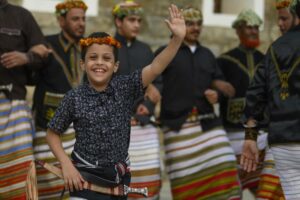Rijal Alma’a Heritage Village is a village located in Rijal Almaa Governorate, located southwest of Saudi Arabia, in the Asir region, close to the city of Abha. The origins of the village date back to almost 1000 years ago, being an important point of connection for people coming from Yemen, from the east, and especially for the people passing through Makkah and Madinah, which contributed to the development of the village as an important commercial centre. The small village is characterised by the design and architecture of its buildings which look like they were made of gingerbread, therefore the recognition of “gingerbread village”.
Saudi Arabia’s national authorities including the Ministry of Culture and the Heritage Commission have adopted a rehabilitation project for the village with the participation of partners from the public and private sectors, aimed toward making tourism a key driver for sustainable rural development. The tourism strategy aims to create an economic investment opportunity and transform the Rijal Almaa area into a tourist attraction by restoring the village’s architecture historical style without compromising the original identity.
Additionally, the Rijal Heritage Village will be integrated with the surrounding environment in the governorate to create a cultural tourism path and create unique tourism experiences in the Asir region, which are expected to significantly support rural development. Proximity of the village to the city of Abha and the Al-Soudah area will help in establishing Rijal Almaa as an interactive linking point for tourists, contributing to the sustainable operation of the heritage town.
HIGHLIGHTS
-

An ancient trade centre still vibrant and bridging cultures
Rijal Almaa was a village linked to the some of the main trade and pilgrimage routes, from north to south of Saudi Arabia, but also to secondary routes that connected the Eastern world to the Western one. The village is one of the only remaining centres where these traditions are still embraced and celebrated, especially during events.
-

An ancient traditional garment that has passed on through generations
Ever heard of the “futa” attire? It is a wraparound skirt with vibrant stripes worn by men. These people are named Flower Men, since they adorn themselves with floral wreaths, made of intricate and beautiful arrangements of greenery, herbs, and flowers. A distinctive but lesser-known tradition, heritage of their Asir ancestors.

